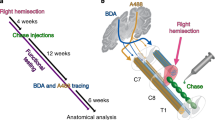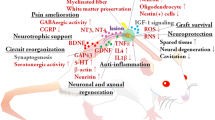Abstract
Chondroitinase ABC treatment promotes spinal cord plasticity. We investigated whether chondroitinase-induced plasticity combined with physical rehabilitation promotes recovery of manual dexterity in rats with cervical spinal cord injuries. Rats received a C4 dorsal funiculus cut followed by chondroitinase ABC or penicillinase as a control. They were assigned to two alternative rehabilitation procedures, the first reinforcing skilled reaching and the second reinforcing general locomotion. Chondroitinase treatment enhanced sprouting of corticospinal axons independently of the rehabilitation regime. Only the rats receiving the combination of chondroitinase and specific rehabilitation showed improved manual dexterity. Rats that received general locomotor rehabilitation were better at ladder walking, but had worse skilled-reaching abilities than rats that received no treatment. Our results indicate that chondroitinase treatment opens a window during which rehabilitation can promote recovery. However, only the trained skills are improved and other functions may be negatively affected.
This is a preview of subscription content, access via your institution
Access options
Subscribe to this journal
Receive 12 print issues and online access
$209.00 per year
only $17.42 per issue
Buy this article
- Purchase on Springer Link
- Instant access to full article PDF
Prices may be subject to local taxes which are calculated during checkout






Similar content being viewed by others
References
Dunlop, S.A. Activity-dependent plasticity: implications for recovery after spinal cord injury. Trends Neurosci. 31, 410–418 (2008).
Wolf, S.L. et al. Effect of constraint-induced movement therapy on upper extremity function 3 to 9 months after stroke: the EXCITE randomized clinical trial. J. Am. Med. Assoc. 296, 2095–2104 (2006).
Dobkin, B. et al. Weight-supported treadmill vs over-ground training for walking after acute incomplete SCI. Neurology 66, 484–493 (2006).
Anderson, K.D. Targeting recovery: priorities of the spinal cord-injured population. J. Neurotrauma 21, 1371–1383 (2004).
Courtine, G. et al. Can experiments in nonhuman primates expedite the translation of treatments for spinal cord injury in humans? Nat. Med. 13, 561–566 (2007).
Anderson, K.D., Gunawan, A. & Steward, O. Spinal pathways involved in the control of forelimb motor function in rats. Exp. Neurol. 206, 318–331 (2007).
Bareyre, F.M. et al. The injured spinal cord spontaneously forms a new intraspinal circuit in adult rats. Nat. Neurosci. 7, 269–277 (2004).
Buchli, A.D. & Schwab, M.E. Inhibition of Nogo: a key strategy to increase regeneration, plasticity and functional recovery of the lesioned central nervous system. Ann. Med. 37, 556–567 (2005).
Galtrey, C.M. & Fawcett, J.W. The role of chondroitin sulfate proteoglycans in regeneration and plasticity in the central nervous system. Brain Res. Rev. 54, 1–18 (2007).
Galtrey, C.M., Kwok, J.C., Carulli, D., Rhodes, K.E. & Fawcett, J.W. Distribution and synthesis of extracellular matrix proteoglycans, hyaluronan, link proteins and tenascin-R in the rat spinal cord. Eur. J. Neurosci. 27, 1373–1390 (2008).
Maier, I.C. & Schwab, M.E. Sprouting, regeneration and circuit formation in the injured spinal cord: factors and activity. Phil. Trans. R. Soc. Lond. B 361, 1611–1634 (2006).
Kwok, J.C., Afshari, F., Garcia-Alias, G. & Fawcett, J.W. Proteoglycans in the central nervous system: plasticity, regeneration and their stimulation with chondroitinase ABC. Restor. Neurol. Neurosci. 26, 131–145 (2008).
Pizzorusso, T. et al. Reactivation of ocular dominance plasticity in the adult visual cortex. Science 298, 1248–1251 (2002).
Massey, J.M. et al. Chondroitinase ABC digestion of the perineuronal net promotes functional collateral sprouting in the cuneate nucleus after cervical spinal cord injury. J. Neurosci. 26, 4406–4414 (2006).
García-Alías, G. et al. Therapeutic time window for the application of chondroitinase ABC after spinal cord injury. Exp. Neurol. 210, 331–338 (2008).
Whishaw, I.Q., Gorny, B. & Sarna, J. Paw and limb use in skilled and spontaneous reaching after pyramidal tract, red nucleus and combined lesions in the rat: behavioral and anatomical dissociations. Behav. Brain Res. 93, 167–183 (1998).
Girgis, J. et al. Reaching training in rats with spinal cord injury promotes plasticity and task specific recovery. Brain 130, 2993–3003 (2007).
Starkey, M.L. et al. Assessing behavioural function following a pyramidotomy lesion of the corticospinal tract in adult mice. Exp. Neurol. 195, 524–539 (2005).
Pettersson, L.G., Alstermark, B., Blagovechtchenski, E., Isa, T. & Sasaski, S. Skilled digit movements in feline and primate recovery after selective spinal cord lesions. Acta Physiol. (Oxf.) 189, 141–154 (2007).
Freund, P. et al. Anti-Nogo-A antibody treatment enhances sprouting of corticospinal axons rostral to a unilateral cervical spinal cord lesion in adult macaque monkey. J. Comp. Neurol. 502, 644–659 (2007).
Cho, S.H. et al. Motor outcome according to the integrity of the corticospinal tract determined by diffusion tensor tractography in the early stage of corona radiata infarct. Neurosci. Lett. 426, 123–127 (2007).
McKenna, J.E. & Whishaw, I.Q. Complete compensation in skilled reaching success with associated impairments in limb synergies after dorsal column lesion in the rat. J. Neurosci. 19, 1885–1894 (1999).
Steward, O., Zheng, B., Ho, C., Anderson, K. & Tessier-Lavigne, M. The dorsolateral corticospinal tract in mice: an alternative route for corticospinal input to caudal segments following dorsal column lesions. J. Comp. Neurol. 472, 463–477 (2004).
Ramanathan, D., Conner, J.M. & Tuszynski, M.H. A form of motor cortical plasticity that correlates with recovery of function after brain injury. Proc. Natl. Acad. Sci. USA 103, 11370–11375 (2006).
Beazley, L.D. et al. Training on a visual task improves the outcome of optic nerve regeneration. J. Neurotrauma 20, 1263–1270 (2003).
Adkins, D.L., Hsu, J.E. & Jones, T.A. Motor cortical stimulation promotes synaptic plasticity and behavioral improvements following sensorimotor cortex lesions. Exp. Neurol. 212, 14–28 (2008).
Hovda, D.A. & Fenney, D.M. Amphetamine with experience promotes recovery of locomotor function after unilateral frontal cortex injury in the cat. Brain Res. 298, 358–361 (1984).
Ying, Z., Roy, R.R., Edgerton, V.R. & Gomez-Pinilla, F. Exercise restores levels of neurotrophins and synaptic plasticity following spinal cord injury. Exp. Neurol. 193, 411–419 (2005).
Petruska, J.C. et al. Changes in motoneuron properties and synaptic inputs related to step training after spinal cord transection in rats. J. Neurosci. 27, 4460–4471 (2007).
Plunet, W.T. et al. Dietary restriction started after spinal cord injury improves functional recovery. Exp. Neurol. 213, 28–35 (2008).
Anderson, K.D., Gunawan, A. & Steward, O. Quantitative assessment of forelimb motor function after cervical spinal cord injury in rats: relationship to the corticospinal tract. Exp. Neurol. 194, 161–174 (2005).
Ribotta, M.G. et al. Activation of locomotion in adult chronic spinal rats is achieved by transplantation of embryonic raphe cells reinnervating a precise lumbar level. J. Neurosci. 20, 5144–5152 (2000).
de Leon, R.D., Hodgson, J.A., Roy, R.R. & Edgerton, V.R. Locomotor capacity attributable to step training versus spontaneous recovery after spinalization in adult cats. J. Neurophysiol. 79, 1329–1340 (1998).
De Leon, R.D., Hodgson, J.A., Roy, R.R. & Edgerton, V.R. Full weight–bearing hindlimb standing following stand training in the adult spinal cat. J. Neurophysiol. 80, 83–91 (1998).
Allred, R.P. & Jones, T.A. Maladaptive effects of learning with the less-affected forelimb after focal cortical infarcts in rats. Exp. Neurol. 210, 172–181 (2008).
Lin, R., Kwok, J.C., Crespo, D. & Fawcett, J.W. Chondroitinase ABC has a long-lasting effect on chondroitin sulphate glycosaminoglycan content in the injured rat brain. J. Neurochem. 104, 400–408 (2008).
Fawcett, J.W. et al. Guidelines for the conduct of clinical trials for spinal cord injury as developed by the ICCP panel: spontaneous recovery after spinal cord injury and statistical power needed for therapeutic clinical trials. Spinal Cord 45, 190–205 (2007).
Galtrey, C.M., Asher, R.A., Nothias, F. & Fawcett, J.W. Promoting plasticity in the spinal cord with chondroitinase improves functional recovery after peripheral nerve repair. Brain 130, 926–939 (2007).
Kozlowski, D.A., James, D.C. & Schallert, T. Use-dependent exaggeration of neuronal injury after unilateral sensorimotor cortex lesions. J. Neurosci. 16, 4776–4786 (1996).
Biernaskie, J., Chernenko, G. & Corbett, D. Efficacy of rehabilitative experience declines with time after focal ischemic brain injury. J. Neurosci. 24, 1245–1254 (2004).
Bradbury, E.J. et al. Chondroitinase ABC promotes functional recovery after spinal cord injury. Nature 416, 636–640 (2002).
García-Alías, G. et al. Recovery of hindlimb motor function after a lateral spinal cord hemisection in adult rats is enhanced by combined administration of NT-3, NMDA-2D subunits and chondroitinase-ABC. Soc. Neurosci. Abstr. 646, 21 (2006).
Courtine, G. et al. Recovery of supraspinal control of stepping via indirect propriospinal relay connections after spinal cord injury. Nat. Med. 14, 69–74 (2008).
Lemon, R.N. & Griffiths, J. Comparing the function of the corticospinal system in different species: organizational differences for motor specialization? Muscle Nerve 32, 261–279 (2005).
Blöchlinger, S., Weinmann, O., Schwab, M.E. & Thallmair, M. Neuronal plasticity and formation of new synaptic contacts follow pyramidal lesions and neutralization of Nogo-A: a light and electron microscopic study in the pontine nuclei of adult rats. J. Comp. Neurol. 433, 426–436 (2001).
Benowitz, L.I., Goldberg, D.E., Madsen, J.R., Soni, D. & Irwin, N. Inosine stimulates extensive axon collateral growth in the rat corticospinal tract after injury. Proc. Natl. Acad. Sci. USA 96, 13486–13490 (1999).
Grill, R., Murai, K., Blesch, A., Gage, F.H. & Tuszynski, M.H. Cellular delivery of neurotrophin-3 promotes corticospinal axonal growth and partial functional recovery after spinal cord injury. J. Neurosci. 17, 5560–5572 (1997).
Whishaw, I.Q., Pellis, S.M., Gorny, B., Kolb, B. & Tetzlaff, W. Proximal and distal impairments in rat forelimb use in reaching follow unilateral pyramidal tract lesions. Behav. Brain Res. 56, 59–76 (1993).
Yamamoto, M., Raisman, G. & Li, Y. Loss of directed fore-limb reaching after destruction of spinal grey matter. Brain Res. 1265, 47–52 (2009).
Acknowledgements
The authors acknowledge key advice and assistance from H. Steenson in animal care and testing. This work was funded by grants from the Medical Research Council, The Wellcome Trust, The Christopher and Dana Reeve Foundation Consortium, The EU Framework 6 Network of Excellence NeuroNE, the Henry Smith Charity and Action Medical Research.
Author information
Authors and Affiliations
Contributions
G.G.-A. and J.W.F. designed the experiments. G.G.-A., S.B. and M.B. performed the experiments. G.G.-A. and J.W.F. analyzed the data and wrote the paper.
Corresponding author
Ethics declarations
Competing interests
James W Fawcett is a paid consultant for Acorda Therapeutics and Alseres Pharmaceuticals.
Supplementary information
Supplementary Text and Figures
Supplementary Figures 1–7 (PDF 2860 kb)
Supplementary Video 1
Animal's performance in Whishaw's skilled paw reaching apparatus. (MOV 399 kb)
Supplementary Video 2
Task-specific and general rehabilitation therapies. (MOV 200 kb)
Supplementary Video 3
Animal's performance in the staircase. (MOV 444 kb)
Rights and permissions
About this article
Cite this article
García-Alías, G., Barkhuysen, S., Buckle, M. et al. Chondroitinase ABC treatment opens a window of opportunity for task-specific rehabilitation. Nat Neurosci 12, 1145–1151 (2009). https://doi.org/10.1038/nn.2377
Received:
Accepted:
Published:
Issue Date:
DOI: https://doi.org/10.1038/nn.2377
This article is cited by
-
Low oral dose of 4-methylumbelliferone reduces glial scar but is insufficient to induce functional recovery after spinal cord injury
Scientific Reports (2023)
-
Regulation of axonal regeneration after mammalian spinal cord injury
Nature Reviews Molecular Cell Biology (2023)
-
Suppression of Microglial ERO1a Alleviates Inflammation and Enhances the Efficacy of Rehabilitative Training After Ischemic Stroke
Molecular Neurobiology (2023)
-
Corticospinal-specific Shh overexpression in combination with rehabilitation promotes CST axonal sprouting and skilled motor functional recovery after ischemic stroke
Molecular Neurobiology (2023)
-
Genetic control of neuronal activity enhances axonal growth only on permissive substrates
Molecular Medicine (2022)



